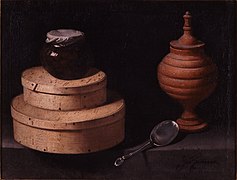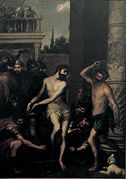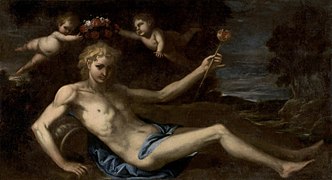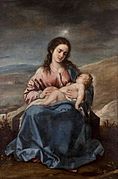Museo de Bellas Artes de Granada
The Museo de Bellas Artes de Granada exhibits the largest collection of ancient art in the Andalusian city of Granada . Most of the works are related to the city; since 1958 the museum has been located on the upper floor of the Palacio de Carlos V in the Alhambra complex .
history
Like many of the country's provincial museums, a large part of this collection stems from the dismortment in Spain , in the course of which numerous works of art that previously belonged to religious institutions were transferred into state ownership. Accordingly, a large part of the collection is related to the church.
The museum was established on August 11, 1839 in the rooms of the Dominican monastery of Santa Cruz la Real. In 1889 the government of Granada decided to use the building for a military facility. In the following years the museum changed its location several times until it moved into the Casa del Castril at the beginning of the 20th century, the rooms of which it shared with the Museo Arqueológico de Granada.
The plan to integrate the museum into the Palacio de Carlos V existed early on, but the decision was not made until 1941. The move finally took place in 1958 as part of the celebrations for the 500th anniversary of the death of Charles V.
Collections
The collections mostly include paintings and sculptures from the 15th to 20th centuries. One of the oldest pieces in the collection is the late 15th century sculpture of Santa María de la Alhambra , attributed to Roberto Alemán , which formerly graced the Alhambra's Puerta de la Justicia . The triptych of the Gran Capitán, executed in enamel on copper, dates from around the same time .
The collection also includes various works by Juan Sánchez Cotán from the 17th century, including Bodegón con cardo y zanahorias (English: still life with cardoon and carrots ), one of the museum's most highly valued works.
By Alonso Cano , the founder of the Granada school of painting, you will find La Virgen del Lucero (German: The Virgin with the Morning Star ) and San Jerónimo penitente en el desierto (German: Saint Jerome in the desert).
The vision of St. Mary Magdalene of Pazzi , Pedro de Moya
Containers for sweets, Juan van der Hamen y León .
Flagellation of Christ , Juan de Sevilla.
Allegory of the Darro River , Pedro Atanasio Bocanegra .
The Virgin with the Morning Star , Alonso Cano .
Web links
Coordinates: 37 ° 10 '36.4 " N , 3 ° 35' 23.7" W.







